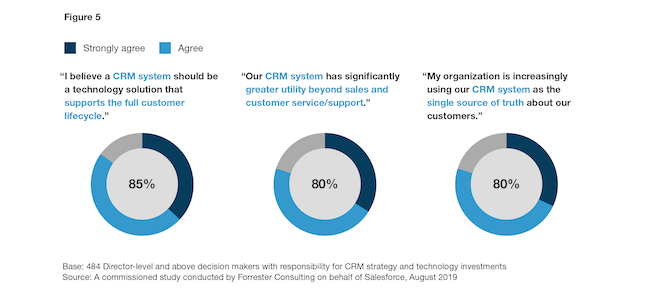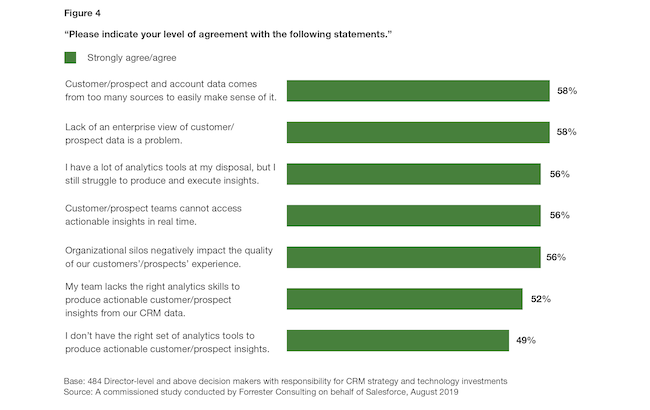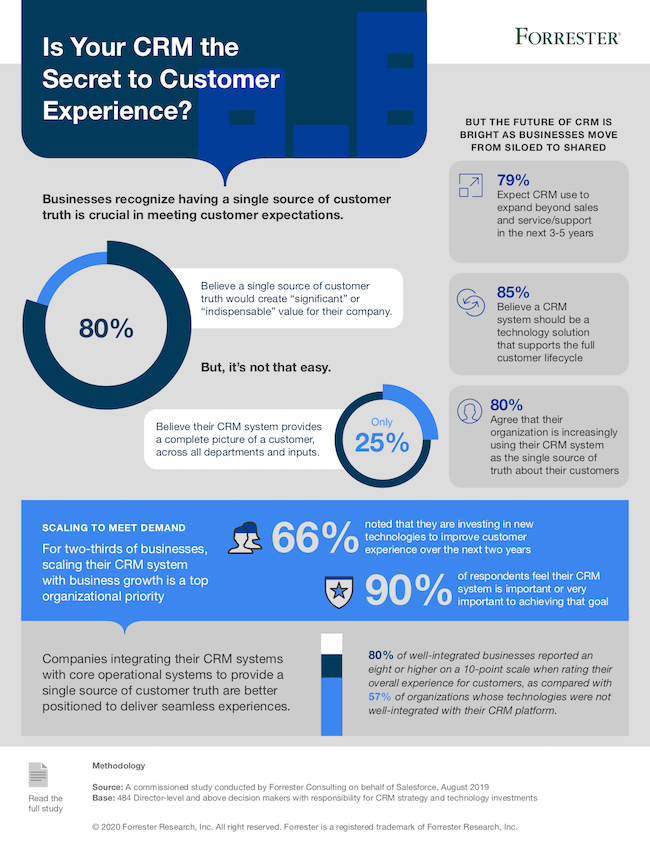Get your FREE 30-day trial.
Start by selecting a product:
Salesforce partnered with Forrester Consulting to evaluate the use of CRM systems across a wide range of industries. The findings show the core challenges facing business leaders today and how they’re investing in customer-centricity for tomorrow.
It’s fiscal year planning time, and as the departmental leader, you’re eager to invest in new technology to improve customer experience metrics and performance for your team. There’s immense pressure to deliver quickly, so involving other departments isn’t an option right now, but you’ll be sure to include them in the future.
Sound familiar?
New research shows four out of five organisations are investing in CRM to support customer-focused strategies. Yet departmental buyers have traditionally purchased CRM in isolation to solve a single business problem, resulting in a majority reporting that CRM systems are at least somewhat fragmented across their organisations.
These findings highlight a central problem: applying technology to old ways of doing things doesn’t magically change the way teams deliver customer experience at scale. When departmental leaders buy and implement CRM in silos, the real shift to customer-centricity remains out of reach.
But there is a way forward. Let’s look at the data to see whether CRM really is the secret to connecting your business silos. We’ll unpack the core challenges facing business leaders today, how they’re investing in customer-centricity for tomorrow, and how that shift can pay off in a major way.
In Fall 2019, Salesforce commissioned Forrester Consulting to evaluate the use of CRM systems across a wide range of industries. Forrester surveyed 484 business leaders with decision-making responsibility for CRM strategy at their organisations.
Business leaders recognise the importance of gaining a single source of customer truth and overwhelmingly agreed that CRM should support the complete customer lifecycle.

The challenge is that there’s an overwhelming discrepancy between expectations for what a CRM system should support and how CRM is actually being used in businesses of all sizes and industries.

Business leaders want a single source of customer truth and believe their CRM system has significantly greater utility beyond their sales and service departments, but are struggling to unify data across their teams and systems.
In fact, the report shows “creating a single view of the customer across teams and systems is the greatest customer experience challenge faced by business leaders today.”
How did it become so difficult?
A majority of respondents (57%) reported that their CRM is at least somewhat fragmented across the organisation, with a few, many, or all departments having their own CRM. This is a result of departments pursuing initiatives in silos — such as modernising sales, customer service, or existing applications.
Incremental improvement is possible when departmental buyers purchase CRM in isolation to solve a single business problem. But it doesn’t transform the business. In fact, siloing these efforts may be contributing to greater difficulties.
As the data shows, customer data is coming from too many sources to make sense of it easily, and these silos are negatively impacting the quality of customer and prospect experiences.

So how does an organisation move past these challenges to leverage the full power of CRM and gain a unified view of the customer?
Before we can take meaningful steps toward customer-centricity, it’s important to recognise what’s possible when multiple teams unite around a single customer view.
I think back to my recent experience of buying a new car:
All of the departments I engaged with seemed to operate as a single unit, and had the right data and tools at hand to deliver a great experience. I was grateful to have purchased this particular car — not because of the quality of the product, but due to the quality of my experience as a customer.
CRM can be the single source of truth, bringing together marketing, sales, commerce, service, and back office departments, and 80% of those surveyed agreed they are increasingly using their CRM system as so. But it requires businesses to look holistically at their processes and how they put the customer at the center.
Leading businesses are evolving to put the customer in the center of their feedback loop and innovation cycle in what we call customer 360 transformation. For example, in the ASEAN region, companies like Bluebird Group, Prudential Singapore, and Anantara Vacation Club have made their CRM the single source of customer truth.
These businesses integrate their CRM system with core operational systems to prove a single source of customer truth, resulting in broader teams connecting around the customer. And those efforts are paying off: the research shows businesses that successfully connect departments on a well-integrated CRM platform report significantly higher customer satisfaction.

CRM alone isn’t the secret to breaking down silos. As more businesses employ the right mindsets, disciplines, and tech stack to bring their silos together, CRM can serve as a key driver of transformation.
Read the Forrester report to dive deeper into the findings.
Also, check out the Transformation Playbook and this post on designing customer-centric business processes.
This post originally appeared on the U.S.-version of the Salesforce blog.